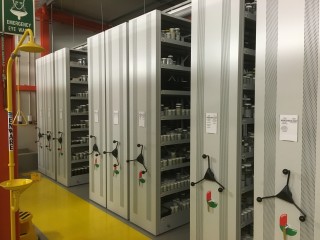Every now and then it’s worth a review of what we’re doing. So, two weeks ago we ran an in-house “Collections Recap” session to review the work that we’ve been doing in this area. I also realised that I’ve been asked “why” we work in Collections and Archives a few times lately, so it seems timely to do a recap in our blog as well.

Back in the “good old days” – trying to identify a small snake through scale patterns
One of our first – and still ongoing – clients is the Western Australian Museum. I was first introduced to them back in the days when I was doing ecological and biodiversity survey work as an environmental consultant (see a younger me on the right). During this time I was introduced to the important work that they do in research and taxonomic regulation of the fauna of Western Australia (see their recent post on this subject here). Shortly after starting with the Museum, we ended up doing work with the Western Australian Herbarium, who along with a great deal of research, manage the Western Australian floral taxonomy.
Our little adventure into Collections started right there with a series of Microsoft Access databases, Dreamweaver based web sites, and a bunch of other technology that seems… quaint… by today’s standards.
This was all a totally natural (ha!) fit for us as a company – and then Collections suddenly got more complex when we were introduced to the Archives. Archives share a lot of attributes with these other Collection institutions; you could make the highly superficial observation that they both have to manage large volumes of ‘things on shelves’.

The “shelves” at the Western Australian Museum store some invaluable objects
There are some key differences between them – different data standards, no real ‘loans’ (except to the reading room) – but one big difference is that Archives deal with Digital Preservation (note the capital letters) a lot more than the other Collections organisations do.
Digital Preservation is a difficult area to master, but it is relatively easy to understand – it is basically our attempts to make sure that digital files are accessible in the future. A simple statement, but think about format changes, bit rot, viruses, hard drives failing… and then think about digital files that are stored in less “simple” formats, like web sites and databases – and then think about the required software to read them, operating systems to run the software, and much more – it gets complex pretty quickly in the details.
But here’s the thing – across the biological Collections community there is the creation of a large number and type of digital files – images, 3D scans, Xrays, genetic sequence data, and more – but the Digital Preservation side of things is still embryonic, and we’re hoping to change that, to help preserve our biological information – forever.

How do we preserve even simple biological digital resources – like this photo I took of Nephrurus wheeleri in the field?
This “forever” concept is another important one. Archives deal with a timespan that is literally “forever” – enshrined in legislation and policies. This is a really key difference, and it’s one that we think needs to be brought back to a range of other areas, including the broader Collections community. So our approach here was to learn as much as we can from the Archives community so that we can help this broader community to preserve the important digital resources that we have around our biological collections.
So that’s why we ended up working in the Collections area – and by association, with Archives. After our internal review session, I really think that we’re starting to do this – and bring Digital Preservation to the broader community. We’ll be blogging about our projects in this space in due course, as well as writing up project summaries.
In the meantime, if you want to talk to us about Collections, Archives, Digital Preservation, or make jokes about my receeding hairline, then drop me a line at piers.higgs@archive.gaiaresources.com.au, or start a conversation with us on Facebook, Twitter or LinkedIn..
Piers

Comments are closed.